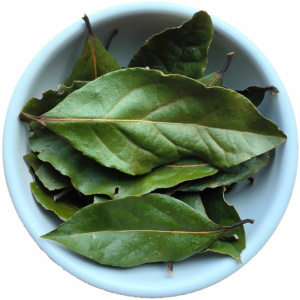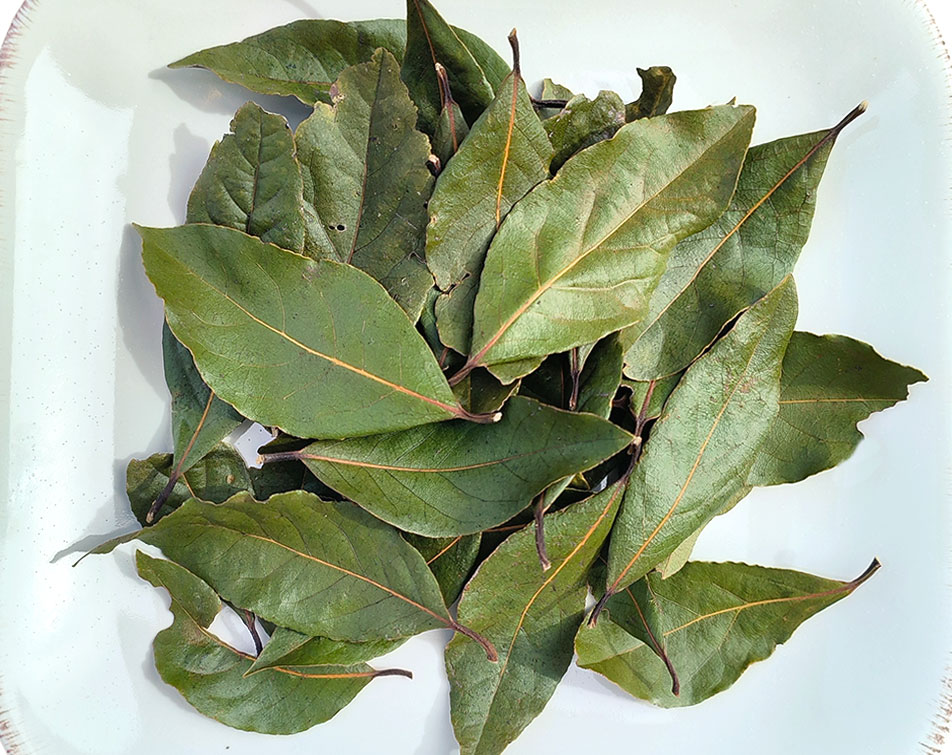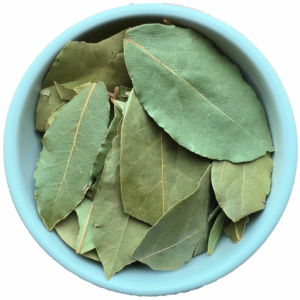Bay Leaves and the culinary standards
Bay leaves have graced kitchens across the world for millennia, transforming simple ingredients into complex, aromatic dishes with their distinctive fragrance and subtle flavor. These unassuming leaves, often removed before serving yet essential to countless recipes, represent one of the most universally appreciated herbs in global cuisine. From the sun-drenched hillsides of the Mediterranean to the volcanic soils of the Azores (photographed in the main image of the article), different varieties of bay leaves tell unique stories of terroir, tradition, and culinary innovation.
The Mediterranean Foundation: Laurus nobilis
The story of bay leaves begins in the Mediterranean basin, where Laurus nobilis, the “true bay” or “sweet bay,” has flourished for thousands of years. This evergreen tree, native to the region stretching from Turkey through Greece and into the western Mediterranean, produces the bay leaves most familiar to European and American cooks. The Mediterranean bay leaf carries deep cultural significance, having been woven into laurel crowns for ancient Olympic champions and Roman poets, giving rise to terms like “poet laureate” that persist today.
Mediterranean bay leaves possess a complex aromatic profile characterized by subtle pine, eucalyptus, and mint notes, with underlying hints of clove and lavender. When fresh, these leaves maintain a bitter edge that mellows considerably during cooking, developing into a warm, woodsy flavor that enhances without overwhelming. The leaves contain essential oils including eucalyptol, cineole, and pinene, which release their fragrance slowly during prolonged cooking, making them ideal for braises, stews, and stocks that simmer for hours.
The cultivation of Mediterranean bay requires well-draining soil and full to partial sunlight, thriving in the warm, dry summers and mild winters characteristic of its native region. These growing conditions concentrate the essential oils within the leaves, creating the distinctive flavor profile that has made Mediterranean bay leaves the gold standard for culinary applications worldwide.
Turkish Bay Leaves: The Culinary Gold Standard
Among Mediterranean varieties, Turkish bay leaves have earned particular acclaim from professional chefs and home cooks alike. Grown in the mountainous regions around Mersin in southern Turkey, these leaves benefit from unique climatic conditions where Mediterranean and Aegean winds carry moisture across the growing areas, creating ideal conditions for bay cultivation.
Turkish bay leaves are characterized by their oval shape, measuring typically one to four inches in length, with a more rounded form compared to their California cousins. Their flavor profile is notably more refined and nuanced than other varieties, offering a gentler, sweeter taste with less of the assertive menthol character found in some bay leaf varieties. This subtlety makes Turkish bay leaves particularly versatile, allowing them to complement delicate dishes without dominating the flavor profile.
The superior quality of Turkish bay leaves stems from both growing conditions and harvesting practices. The mountainous terrain and specific wind patterns create stress conditions that concentrate essential oils, while traditional harvesting methods preserve the integrity of the leaves. These factors combine to produce bay leaves with exceptional depth of flavor that develops complexity during cooking rather than simply providing a single dominant note. If you want to try these we can supply, just contact us!
California Bay: A Distinctive American Alternative
The California bay leaf, harvested from Umbellularia californica, represents a completely different species despite sharing the common name. Native to California and Oregon, these leaves offer a markedly different culinary experience characterized by their intense, almost medicinal eucalyptus flavor and stronger menthol character.
California bay leaves are easily distinguished by their elongated, lance-shaped form, typically measuring two to five inches in length with smooth edges and a pronounced point. Their flavor is significantly more potent than Mediterranean varieties, requiring careful use to avoid overwhelming dishes. Fresh California bay leaves are particularly intense, with some culinary experts recommending using only one-quarter to one-half the amount called for in recipes designed for Turkish bay leaves.
Despite their intensity, California bay leaves have found their place in American regional cuisine, particularly in dishes where their robust character can stand up to equally bold flavors. Some chefs appreciate their distinctive profile for specific applications, including certain desserts where their menthol qualities can provide an interesting counterpoint to sweet ingredients.
The Azorean Treasure: Laurus azorica
 The volcanic islands of the Azores, scattered across the Atlantic eight hundred miles west of Portugal, nurture their own unique bay leaf variety: Laurus azorica. This endemic species, closely related to the Mediterranean bay but evolved in isolation, represents a fascinating example of how geographic separation can create distinct culinary treasures.
The volcanic islands of the Azores, scattered across the Atlantic eight hundred miles west of Portugal, nurture their own unique bay leaf variety: Laurus azorica. This endemic species, closely related to the Mediterranean bay but evolved in isolation, represents a fascinating example of how geographic separation can create distinct culinary treasures.Azorean bay leaves share the aromatic complexity of their Mediterranean cousins while developing their own unique characteristics influenced by the islands’ volcanic soil and oceanic climate. The persistent mild temperatures and high humidity of the Azores create growing conditions that produce leaves with a slightly different chemical composition, resulting in a more subtle, refined flavor profile that many describe as having hints of the sea air that surrounds their growing environment.
The culinary traditions of the Azores incorporate these native bay leaves into dishes that reflect the islands’ position between European and New World influences. Traditional Azorean beef stews, where meat is marinated with garlic, onions, bay leaves, allspice, and red wine before slow cooking, showcase how these leaves contribute to the complex flavors that define Azorean cuisine. The unique terroir of volcanic soil enriched by Atlantic moisture creates bay leaves that complement the islands’ distinctive ingredients, from locally raised beef to exotic spices brought by centuries of maritime trade. If you want to try these we can supply, just contact us!
Indian Bay Leaves: The Misunderstood Tej Patta
Perhaps no bay leaf variety causes more confusion than the Indian bay leaf, known as tej patta in Hindi. Despite sharing the common name “bay leaf,” Cinnamomum tamala belongs to an entirely different botanical family than Mediterranean bay leaves. This distinction is crucial for cooks seeking authentic flavors in Indian cuisine, as the two cannot be substituted without significantly altering the intended taste profile.
Tej patta leaves are easily identified by their distinctive three parallel veins running lengthwise, contrasting sharply with the branched vein pattern of true bay leaves. Their flavor profile bears more resemblance to cinnamon and cloves than to the piney, eucalyptus notes of Mediterranean bay, reflecting their botanical relationship to the cinnamon tree. This warming, spice-like character makes tej patta essential to Northern Indian cuisine, particularly in Mughlai dishes like biryani and korma.
The use of tej patta in Indian cooking extends far beyond simple flavoring. These leaves are fundamental to the development of garam masala and other spice blends that form the foundation of Indian cuisine. Their ability to complement and enhance other warming spices while providing their own distinctive contribution makes them irreplaceable in authentic Indian cooking, despite ongoing confusion with Mediterranean bay leaves in international markets. If you want to order in bulk from our Indian friends, just contact us!
Indonesian Salam Leaves: The Southeast Asian Distinction
Indonesia contributes its own unique leaf to the global bay family with daun salam, harvested from Syzygium polyanthum. Like Indian bay leaves, salam leaves are frequently mistranslated as “bay leaves” in English recipes, despite being botanically distinct and offering completely different flavors.
Salam leaves provide a subtle, earthy flavor with slight citrus notes and a hint of astringency that complements the complex spice blends common in Indonesian cuisine. Unlike Mediterranean bay leaves, which develop their flavor through long cooking, salam leaves require activation through brief frying in oil or boiling in coconut milk to release their aromatic compounds. This technique, common throughout Southeast Asian cooking, demonstrates how different varieties require different approaches to maximize their culinary potential.
The importance of salam leaves in Indonesian cuisine cannot be overstated. They appear in countless traditional dishes from Sumatra to Bali, providing a distinctive flavor that connects diverse regional cuisines across the archipelago. Their subtle character allows them to support other ingredients without competition, making them essential to the layered flavor profiles that characterize Indonesian cooking.
Caribbean Bay Leaves: Island Aromatics
Caribbean cuisine incorporates bay leaves in distinctive ways that reflect the region’s complex cultural heritage and abundant local ingredients. Bay leaves appear prominently in jerk seasoning, where they contribute to the complex marinade alongside scotch bonnet peppers, allspice, and thyme. In this application, bay leaves are often soaked and placed directly on grills, where they release aromatic smoke that infuses grilled meats with their distinctive fragrance.
The Caribbean approach to bay leaves demonstrates how traditional European ingredients adapt to new culinary contexts. Whether used in callaloo, rice and peas, or traditional stews, bay leaves in Caribbean cuisine often work alongside ingredients unknown in their Mediterranean homeland, creating fusion flavors that reflect centuries of cultural exchange and adaptation.
Culinary Applications and Techniques
The versatility of bay leaves across cuisines demonstrates their fundamental importance in global cooking. Their primary function involves long, slow cooking processes where heat gradually extracts essential oils and aromatic compounds. Soups, stews, braises, and stocks represent ideal applications, allowing bay leaves time to release their complex flavors while mellowing any harsh notes.
Different varieties require different approaches to maximize their potential. Mediterranean bay leaves work best when added whole to simmering liquids, where they can slowly infuse their flavor throughout the cooking process. Turkish bay leaves, with their refined character, can be used more liberally than their California counterparts, which require careful moderation to prevent their intense eucalyptus character from overwhelming delicate dishes.
The technique of crushing or tearing bay leaves before use can accelerate flavor release, though this approach requires careful attention to ensure no leaf fragments remain in finished dishes. Ground bay leaves, while convenient, require even more careful use due to their concentrated flavor and inability to be removed before serving.
Rice dishes across cultures showcase bay leaves’ ability to enhance starchy ingredients. From Mediterranean risotto to Indian biryani to Caribbean rice and peas, bay leaves contribute depth and complexity that transforms simple grains into sophisticated side dishes. The technique of adding bay leaves to cooking water for potatoes, beans, or grains demonstrates their ability to enhance even the most basic preparations.
Storage and Selection
Proper storage significantly impacts bay leaf quality and flavor intensity. Dried bay leaves should be stored in airtight containers away from light and heat, maintaining their potency for up to one year when properly preserved. Fresh bay leaves, while more intense in flavor, require immediate use or careful freezing to prevent deterioration.
The quality of bay leaves varies significantly between sources, with whole, unbroken leaves typically offering superior flavor to crushed or ground varieties. Color provides an important quality indicator, with darker leaves generally indicating better flavor concentration. Properly stored bay leaves should retain their aromatic intensity when crushed between fingers, with faded or scentless leaves indicating deterioration.
The Science of Bay Leaf Flavor
The complex flavor profile of bay leaves results from numerous volatile compounds working in harmony. Eucalyptol provides the characteristic eucalyptus notes, while cineole contributes piney undertones. Myrcene adds herbal complexity, and various terpenes provide the subtle background notes that make bay leaves so distinctive.
These compounds are heat-sensitive and water-soluble, explaining why bay leaves work best in moist, slow-cooking applications. The gradual extraction of these aromatics during cooking allows them to integrate fully with other ingredients, creating the subtle but unmistakable depth that characterizes well-seasoned dishes.
Global Appreciation and Future
The global appreciation for bay leaves continues to evolve as cooks become more aware of varietal differences and regional applications. Understanding these distinctions allows for more authentic flavor development and better recipe adaptation across cultural boundaries.
The story of bay leaves represents the broader narrative of global cuisine, where traditional ingredients travel across cultures, adapt to new environments, and create unexpected harmonies with local ingredients. From the ancient laurel groves of the Mediterranean to the volcanic slopes of the Azores, from the spice gardens of India to the tropical islands of Indonesia, bay leaves continue to enhance and elevate cuisines worldwide, proving that sometimes the most humble ingredients create the most profound culinary impact.
Whether you choose the refined subtlety of Turkish bay, the bold character of California varieties, the unique terroir of Azorean leaves, or the warming spice of tej patta, these remarkable leaves offer endless opportunities to deepen and enhance your culinary creations, connecting your kitchen to centuries of global cooking tradition.



